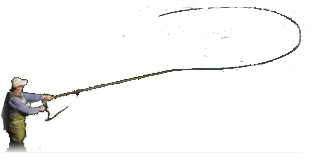One incidental positive objective which was obtained without it actually being a target ( it only became apparent after using the flies) is the attitude of the fly when casting. The wing is always opposite to the direction of casting. Trailing as it were, and is not subjected to being crumpled or otherwise deformed. It is also very much easier to cast into wind, excepting for the last stage of turnover, when a little extra power is required to turn it, as the wings are then facing into the "wind".
To summarise the matter briefly, I think the design is 95% resolved.
Some of the reasons for the effectiveness are not resolved. ( But as long as it IS effective, this is hardly a problem as such. I don't really KNOW why a woolly bugger works either, but I know that it does!).
Various possible adjustments, and specific pattern adaptations are not resolved.
All my fly designs go through at least similar development before they get a place in my box.
The same applies to appearance, behaviour, and properties of materials used in the construction of the fly. It really makes no difference whether it is a tiny midge or a large "plastic" frog! The criteria are basically similar. In many cases shape and behaviour are more important than colour, but colour can be important as well, and it does no harm to try to get it right!
Anyway, the fly in this particular case was my upside down reversed hare dun/emerger/ generic;
Normally I use watershed to pre-treat these flies ( gink and similar paste or gel stuff mats hair fibres and actually makes them likely to sink more quickly! ), but the fly in the photo has indeed been extremely lightly ginked and tossed in a bowl of water as a general experiment. On pretreated flies the wings look more substantial/bulky but are also more transparent, This only works with the right floatant.
The more thought and research you invest in a pattern, both with regard to the natural, and the materials and techniques used for the artificial, the more likely the result is to be successful.
This actually saves a lot of time and effort, as you don't waste a lot of time dressing flies that don't work very well!Or even worse, spending untold amounts of time trying to catch fish with them!!!
So, to conclude the matter for the nonce, I cant say that a particular material like peacock herl is a good "trigger" as such. It is of course successfully used on a number of flies. But there may be many reasons for this, and I simply don't know what they might be.
TL
MC





 Reply With Quote
Reply With Quote